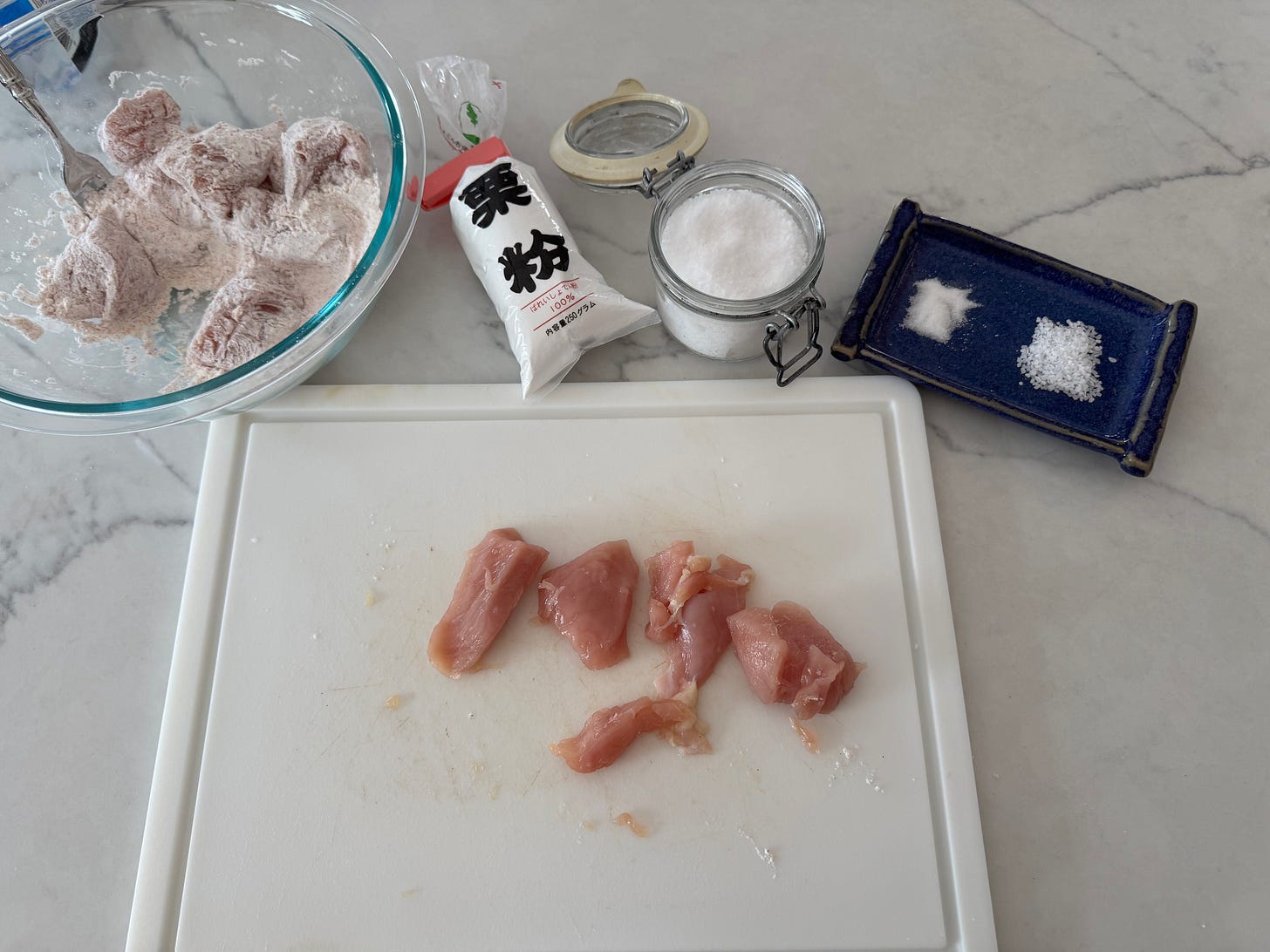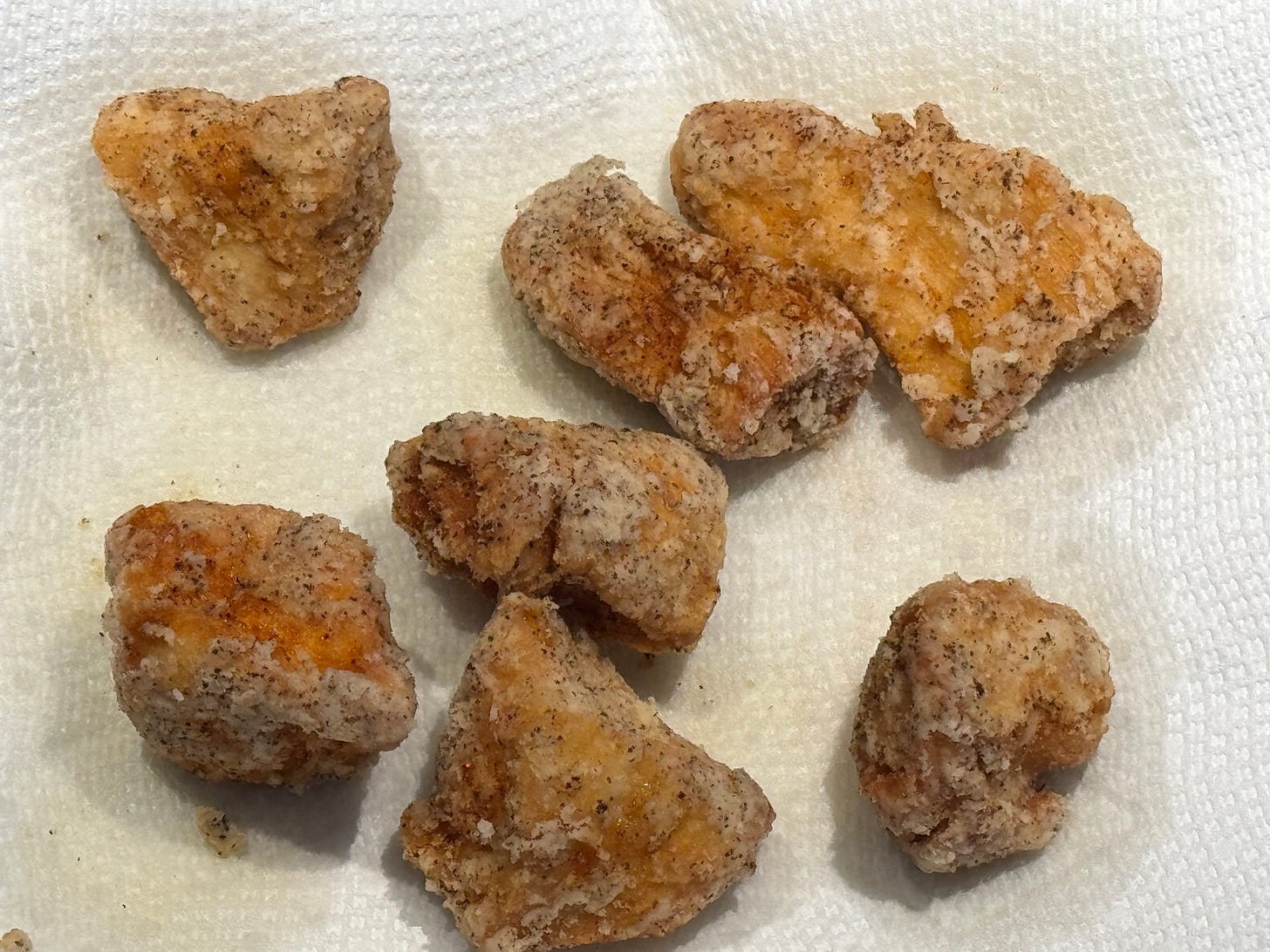My youngest son wanted chicken nuggets. Was craving chicken nuggets. It was the 7th day of Passover, and he’d been avoiding anything resembling bread for a week, crunchy chicken coating included.
Only one more day of observance remained, and I knew he could manage the wait. Trying to be supportive, I muttered something about how committed he’d been so far to keeping symbolically kosher, how happy I knew he would be to enjoy pizza and bread and pasta and yes, chicken nuggets, when the holiday was over.
Discomfort is part of the point: being able to move past physical discomforts is said to bring us closer to our spiritual being, and in the case of Passover, abstinence from chametz — leavened foods made from grains — and kitniyot — legumes, rice, and corn said to resemble chametz — reminds us of our ancestors’ escape from slavery.
There’s Jewish irony for you: celebrate freedom with abstinence! Don’t eat things you love most — because your ancestors suffered and you are free!
In seriousness, I’m touched that my children have opted into some measure of Passover kashrut, or kosher observance. They are the offspring of a mixed marriage and for this reason, we’ve never been deeply religiously observant in our household. My daughter and sons didn’t grow up going to synagogue or Hebrew School the way I did. But they have each, for their own personal reasons, decided that certain Jewish holy day practices, including keeping kosher during Passover and fasting on Yom Kippur, are important to them.
Back to those chicken nuggets:
My mind raced to suggest some alternatives for my son’s lunch. Exercising the superpower that seems to be the exclusive domain of moms, I visualized the contents of our pantry and refrigerator shelves. I remembered we used to have a small package of tofu in the vegetable drawer.
Tofu. Tofu… hmmm. I paused, wondering, is tofu kosher for Passover? This is normal during the 8 days of Passover, overthinking every food and its ingredients.
Now that you may be wondering the answer yourself, I will tell you that tofu is one of those foods that is considered not kosher for Passover by some Jews and okay to eat during Passover by other Jews, depending upon their ancestry and how orthodox their religious practice is. I was raised in a family that didn’t eat kitniyot, so that is my reflex. In my childhood household, tofu would be a Passover no-no.
This was all a distraction. It didn’t matter. My son doesn’t like tofu and we no longer had any. But that tofu invited my monkey brain to hijack my thought process and disrupt my inventory-taking. I started thinking about how tofu is often dredged lightly in cornstarch before sautéing or frying to give it a crispy exterior.
If you’re paying close attention, perhaps you’ve figured out that cornstarch is, you guessed it, classified as kitniyot and therefore, not kosher for Passover.
Cornstarch was out, but it dawned on me that I had potato starch in my pantry. In strictly technical terms, it was not kosher for Passover either, having come from the Japanese market where my daughter works. It was not processed in a kosher facility approved by a rabbi. However, potato is okay to eat during Passover. In loose conformance with kosher guidelines, I could argue that potato starch was a more acceptable ingredient than cornstarch (kitniyot) or breading (chametz).
“I have an idea,” I told my son. “I have no idea how it will turn out.” I explained my hypothesis that seasoned potato starch could make a coating for fried chicken chunks. I promised him that these nuggets definitely would not resemble the ones he is used to. He was undeterred by my caveat and suggested I give it a go.
Mistakes were made. My son was so appreciative of my willingness to work around dietary restrictions that he didn’t mention the nuggets’ impossibly chewy texture after I served him the first batch out of the frying oil. After eating a few, he asked if he could save the rest for later, softly mentioning, “they were a little hard to chew.” I reached over to snatch a nugget from the plate he held aloft and bit into it. It was awful. Stringy and unyielding, about as appetizing as chewing on a hard pink eraser.
I didn’t intend to torture him with poorly executed food. “It’s overcooked!” I laughed. “If it’s giving your jaw a workout, that bird, any chicken, is overdone.” He didn’t know. He barely knows how to cook. Plus, he is thoughtful about not wasting food, so it didn’t occur to him to toss it in the compost pail and ask me for a re-do. Even when I made it clear that this was a trial effort. Utter experimentation.
Most experiments require iteration to get the results right.
With each successive batch, I adjusted the cooking time and temperature. The last of the nuggets were still imperfect but edible. I don’t hesitate to admit some further refinement could be in order.
I’m sharing it for a laugh, or your recommendations (use the comment button), and writing it here in a way that bares my creative process. The words in strikethrough font show what I actually did (or modified along the way, as I cooked batch after batch in my small pot), while the italicized text notes my recommendations for improvements. I didn’t measure seasonings as I added them, so the quantities are best guesstimates.
Less Than Perfect Almost-Kosher Chicken Nuggets**
Yield: approximately 20 nuggets
INGREDIENTS
1 1/2 lb
chicken breastchicken thighs, preferably but not necessarily organicChicken breast is healthier, but chicken thighs, with their higher fat content, are probably better suited for this to produce a juicier nugget and avoid ending up with stringy meat.
1/4 c fine potato starch
1/2 - 1 tsp onion powder
Use powder, not granules or dried onion flakes. I didn’t actually measure. Eyeballing, I used about 1 tsp and it was very onion-forward, so I added in paprika to add balance.
1/4 - 1/2 tsp paprika
I’m guessing I used about 1/2 tsp. I’d measure next time and see how it goes with more precise measurements.
1 tsp kosher salt
Fun fact: kosher salt is coarse-grained salt that gets its name from being used in the process of “koshering” meat**ground black pepper
To taste. Not everyone likes a really peppery bite. I used about 8 turns of my pepper grinder. If I had loose ground pepper, it would have been easier to note quantity.
2 egg whites (?)
This is optional. I didn’t use it when I made these, and my son commented on how the coating crumbled in a powdery way on his fingers. It’s possible that dipping the chicken first into egg white may help the potato starch to adhere to the chicken.1 c high-heat tolerant cooking oil (I used safflower)
You may not need this much, depending upon the size and shape of your pot.
TOOLS
cutting board
sharp knife
small dutch oven or heavy bottomed bottomed deep pan (not a skillet) for frying
thermometer to clip on to side of pot (like a candy thermometer)
paper towels
medium-sized bowl
tongs (long enough to give your hand some distance from the hot oil)
large plate or small baking pan — something to put your chicken nuggets on to drain after cooking
instant-read thermometer
small mesh skimmer/strainer
DIRECTIONS
A note before starting:
The temperature of the cooking oil will reduce somewhat when you introduce raw meat. Adjust your cooking heat as needed to maintain an even cooking temperature of 300-350F throughout the process.
1. Pour cooking oil into small Dutch oven or deep-sided, heavy-bottomed pan. You need it to be about 3” deep, enough to cover most of the chicken while cooking.
Clip thermometer to side of pan.
2. Mix potato starch, onion powder and paprika well in medium bowl.
3. Dry chicken thoroughly with paper towels. I did this twice; a dry surface promotes a crispy exterior.
4. Cut the chicken into 2” chunks. Keep the chunks as close in size as possible for uniform cooking times. I think a smaller pieces might improve the finished texture. Try 1” to 1.5” chunks.
5. Season the chicken meat all over with kosher salt and ground black pepper.
6. Heat the oil to 300-350F over medium-high heat.
7. As the oil is heating, dredge the chicken chunks in the potato starch mixture. If using egg white, put the egg white in a separate bowl and whisk lightly. Dip the chicken chunks into the egg white, shaking off excess before dredging to cover with the potato starch mixture.
8. Line large plate or small baking pan with paper towels. You will drain chicken nuggets here once cooked.
9. Once oil comes to cooking temperature, cook the chicken nuggets in small batches.
- Use long-handled tongs to carefully place chunks one by one into the oil.
- Do not overcrowd the pan. There should be space between the nuggets so that they can “float” in the oil.
- To keep oil from splashing, do not drop the chicken into the oil! Hot oil burns like a @#$% demon. It’s counterintuitive, I know. People get afraid of hot oil and think that if they keep their distance and drop in the food from up high, they are protecting themselves. It doesn’t work that way. The higher the distance, the further the drop, the bigger the splash, the greater the risk of injury.
10. Fry, turning each nugget occasionally, for about eight 3-5 minutes, turning a few times, until the whole thing is crispy and lightly golden.
11. Remove from oil using tongs and place on paper-lined plate to drain. Check internal nugget temperature using instant read thermometer. Fully cooked chicken should register 165F. Adjust cooking time for subsequent batches accordingly.
Repeat. Continue to cook batches until all the meat is used. Skim the oil between batches to remove the crispy bits floating in the oil.

Please remember to hit the Like button and Restack to help others find posts from The Phenomnom! Thank you for spending your time here.
*To be “truly” kosher, all ingredients — chicken, potato starch, oil, etc. — should be marked with a Kosher certification stamp on their packaging or the word “Kosher.” Passover kashrut has special requirements so you’d look for products marked with “Kosher for Passover.” (Don’t worry, plenty of Jews find all of this confusing, too.)
**Koshering meat involves drawing out excess blood from the flesh.









